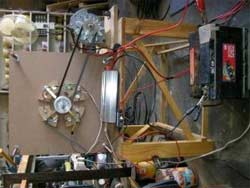An electric motor that produces about 120% more kinetic watts than a conventional motor of the same value has been developed and could soon be available on the commercial market.
Prototype developer Zhaan Jordaan reports that the concept behind the energy efficient drive, which was presented to an independent electrical engineer for testing, is to use 12 volts of DC power supply with 7,5 applied ampere (A). This could enable a drive to produce 288 W of mechanical power on a Dynamometer. Jordaan adds that this is achieved using no fuel on the motor. This could equate to a drive unit that is 300% more efficient then a conventional.
Jordaan began research and development of the drive five years ago while working for the South African government. "My work brought me in close contact with people in the rural areas, where I worked closely with Eskom in funding projects in rural areas. It became apparent that people in rural areas have an enormous problem with electricity. I was also aware of the fact that government had mandated Eskom to supply electricity to a certain number of homes by the year 2015. It was this information that prompted the invention a generator that does not use fuel," says Jordaan.
In 2003, he set about experimenting with permanent magnets to build such a machine.
The traditional belief is that 12 V of dc coupled with 7,5 A, will result in 90 W of electricity, at 90% efficiency, which equates to 81 W.
Jordaan says that one is able to calculate that if a big enough machine is coupled to a 12 V battery and an alternator, it is possible to produce more electrical watts than is used by the device and have surplus amperage to keep the battery fully laden.
Jordaan reports that during testing, the prototype was coupled to a large enough alternator that was capable of generating 120 A of current. The magnetic drive unit used 64 A delivering 2 200 W, which is more than enough to drive the alternator. This left a surplus of 56 A. With this one could drive a 900-W alternating current inverter which would use 49 A and still have a reserve of 7 A which was sufficient to keep the battery fully charged at all times. He adds that although the prototype has not been used on any projects, the foreseeable future is positive.

